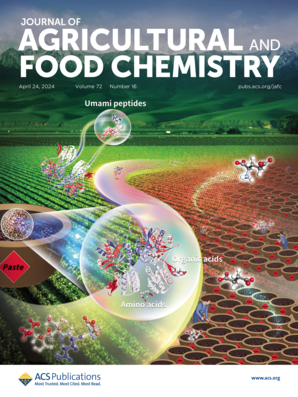Design, Synthesis, Nematicidal Activity Evaluation, and Mode of Action Study of Novel Trifluorobutene Ester Derivatives as Potential Nematicides
IF 5.7
1区 农林科学
Q1 AGRICULTURE, MULTIDISCIPLINARY
引用次数: 0
Abstract
Crop protection globally is under threat from infections caused by plant-parasitic nematodes (PPNs). PPNs can wreak havoc on agricultural production. However, only limited nematicides are currently available, and the growing resistance problem is a concern; therefore, novel nematicides are urgently needed. Thirty-three trifluorobutene ester derivatives were synthesized, and then their biological activity against Meloidogyne incognita was tested in this study. Among them, nine compounds exhibited excellent in vitro bioactivity against M. incognita; their LC50/72h values reached 1.77–3.95 mg/L. In addition, the derivative of the active compound above containing a piperazine ring exhibited significant in vivo bioactivity against M. incognita with an inhibition rate of 77.3% at 1.25 mg/L in matrix. The structure–activity relationships (SARs) of all synthesized compounds were analyzed, and further comparative molecular field analysis (CoMFA) was calculated to discuss the SAR profile. The preliminary mechanisms of action study suggested that some compounds had a great inhibitory effect on the egg hatching, motility, feeding ability, and growth of Caenorhabditis elegans. Meanwhile, the effects of the active compounds on biochemical indices related to oxidative stress indicated that two compounds could significantly promote the oxidative stress of nematodes and induce toxicity through oxidative damage.

作为潜在杀线虫剂的新型三氟丁烯酯衍生物的设计、合成、杀线虫活性评估和作用模式研究
全球作物保护都受到植物寄生线虫(PPNs)感染的威胁。PPN 可对农业生产造成严重破坏。然而,目前可用的杀线虫剂有限,而且抗药性问题日益严重,令人担忧;因此,迫切需要新型杀线虫剂。本研究合成了 33 个三氟丁烯酯衍生物,并测试了它们对褐飞虱的生物活性。其中,9 个化合物对褐飞虱表现出优异的体外生物活性,其 LC50/72h 值达到 1.77-3.95 mg/L。此外,上述活性化合物含有哌嗪环的衍生物对 M. incognita 具有显著的体内生物活性,在基质中 1.25 mg/L 的抑制率为 77.3%。对所有合成化合物的结构-活性关系(SAR)进行了分析,并进一步计算了比较分子场分析(CoMFA),以讨论 SAR 曲线。初步的作用机制研究表明,一些化合物对秀丽隐杆线虫的卵孵化、运动、摄食能力和生长有很大的抑制作用。同时,活性化合物对氧化应激相关生化指标的影响表明,有两种化合物能显著促进线虫的氧化应激,并通过氧化损伤诱导毒性。
本文章由计算机程序翻译,如有差异,请以英文原文为准。
求助全文
约1分钟内获得全文
求助全文
来源期刊
CiteScore
9.90
自引率
8.20%
发文量
1375
审稿时长
2.3 months
期刊介绍:
The Journal of Agricultural and Food Chemistry publishes high-quality, cutting edge original research representing complete studies and research advances dealing with the chemistry and biochemistry of agriculture and food. The Journal also encourages papers with chemistry and/or biochemistry as a major component combined with biological/sensory/nutritional/toxicological evaluation related to agriculture and/or food.

 求助内容:
求助内容: 应助结果提醒方式:
应助结果提醒方式:


